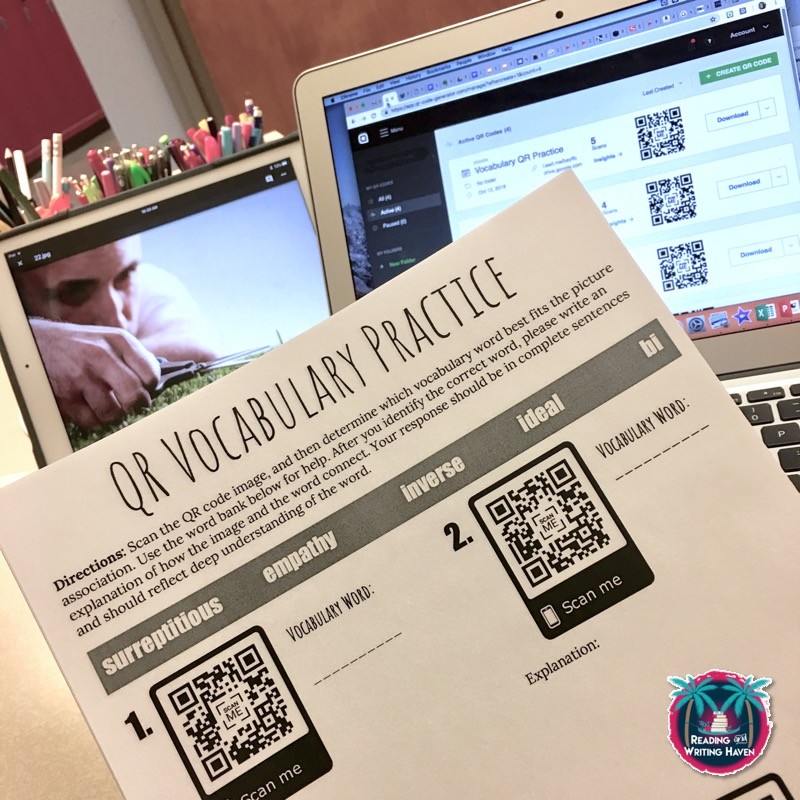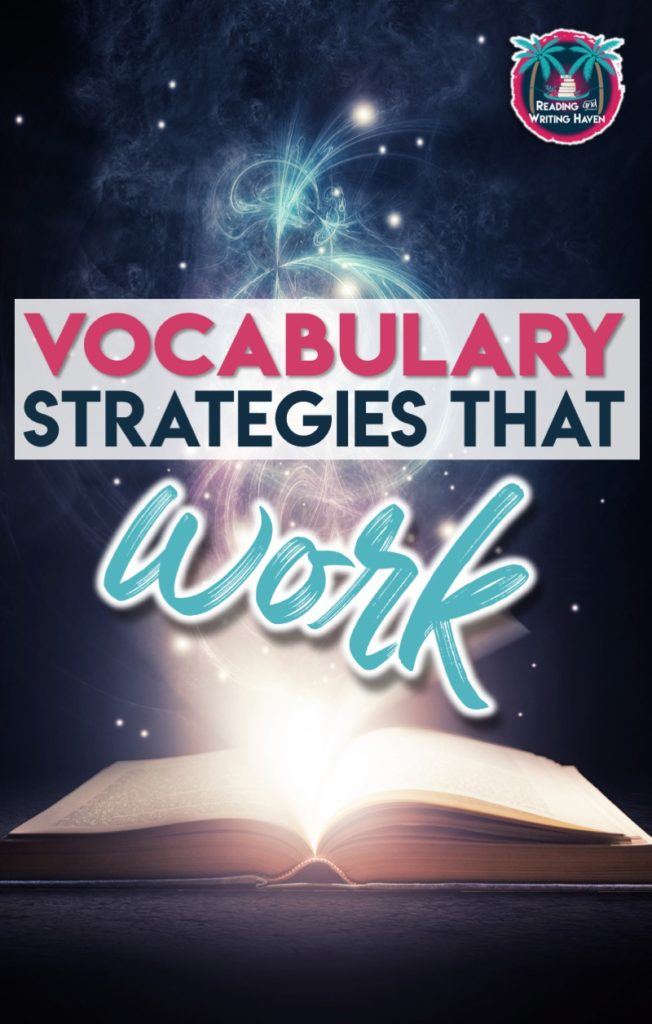Vocabulary Strategies that Work
What’s your current approach to teaching vocabulary? Have you taken time to reflect on how it is working? Do students remember, understand, recognize, and use the words beyond your unit of study? If not, it might be time for a vocabulary strategies overhaul.
There are several key components to an effective vocabulary program, which I wrote about in a previous post. Research has proven that vocabulary acquisition is a valuable component to accelerating students’ learning. Therefore, it’s important that we don’t gloss over it. Spend time reflecting on vocabulary strategies and analyzing student data. It’s the best way to determine if what we are doing is working.
When we aren’t comfortable teaching something (and for some of us, that’s vocab), it can be confusing knowing what to believe. So, let’s begin by debunking some common myths about vocabulary instruction.
Myth #1: I need to assign students a list of 20 words per week.
One critical point to consider is the number of words we assign. I would recommend no more than five new words (or roots) per week. It’s just not reasonable to ask students to master more than that. We have to acknowledge that they do have other classes in which they may be studying vocabulary, not to mention other homework.
Myth #2: There is one correct vocabulary program or list source.
Another question revolves around how we are selecting the words. Some teachers wonder where they can find the Holy Grail of vocabulary lists. Really, the best thing to do is to consider the essential words your students need to understand deeply in order to grasp the higher-order concepts in your unit of study. Often, these are thematic words.
Vocabulary can be divided into three tiers. Most direct instruction regarding vocabulary words should revolve around Tier 2 words (high-frequency words that occur across a variety of domains), but there are times when it’s necessary to include Tier 3 words (context-specific words) on content-area vocabulary lists as well.
There is not one correct source or program for vocabulary. What is important is the frequency and methodology of students’ interactions with the words.
Myth #3: The teacher introduces the words. Students study them.
In order for students to transfer new vocabulary words to their long-term memories, they need to experience the words in multiple contexts and through various layers of thinking. We need to stop expecting students to master new words by studying them on their own. Making time to practice vocabulary during school is one of the keys to success.
Instead of giving students the words and definitions, it’s helpful to allow them to brainstorm possible definitions. By giving them a short passage with context clues, students can infer meaning. They could also try to break apart the word by recognizing and defining roots and prefixes or suffixes. Or, you could give students a picture for the word. Have them come up with possible definitions based on their observations of the image.
Direct instruction is effective. It’s just that it’s not the most effective way to introduce vocabulary words. Instead, use direct instruction time to model how you write with them, how you connect them to life and other words, and how you think critically about them.
I have enjoyed using vocabulary activities as bell-ringers, as literacy center activities, and to engage students after direct instruction. This is an outline of the approaches that have been effective for me. I’ve written about them before, but from different angles and with different examples.
Myth #4: I don’t have time to teach vocabulary.
Translation: It is not important to me. We make time for what matters to us. Vocabulary instruction doesn’t need to take the whole hour, but it is important enough to deserve a sliver of the class period. It’s is important for developing students’ schema, for teaching critical thinking, for improving reading comprehension, for developing a love for literacy, and for determining students’ success, among other reasons.
EFFECTIVE VOCABULARY STRATEGIES
Begin by connecting.
The first thing students need to do with new words is to make connections with them. Some possible strategies to help aid connections are using word walls, examining word parts, drawing or finding associations, writing word bio poems, and playing with word spiders. With word spiders, you begin with a group of words that are all related to the vocabulary word, but you ask students to guess the vocabulary word based on what they know about the other words.
Then, categorize.
Students need to be able to see how the word relates to other words. For example, students can come up with examples and non-examples. They can determine which category all of the words belong in. You can ask them to group their words into smaller categories and then provide explanations of how the words relate. Sketch noting or mind mapping are creative approaches to organizing how students think about their words. Shades of meaning are fun, too.
Next, think critically.
With each step of vocabulary practice, we need to be asking students to do a little more with their words. Some of our practice opportunities should be grounded in deep thinking in order for transfer to occur. One way we can ask students to think deeply about their words is to have them engage in speed dating. Students pretend to be a word and answer questions from that word’s point of view. Another possibility is to ask students to research word etymologies to track how words have evolved over time. Using activities like Bumper Words and short film connections is also effective. This post mentions additional critical thinking exercise ideas for vocabulary.
Make sure students are comfortable with using their words in writing. Model examples for them. Talk about what works and what is awkward. Sometimes, I’ll give my students three sentences and have them choose the one that uses the word correctly. To illustrate:
- Standing akimbo, my mother asked me why I used permanent marker on the walls.
- Mother akimboed as she asked me why I used permanent marker on the walls.
- My mother threw her akimbo at me and asked why I used permanent marker on the walls.
Then, we discuss the usages, which is a great opportunity to connect grammar and vocabulary.
Finally, practice and engage!
A cornerstone to effective vocabulary instruction is incorporating consistent review activities so that students can engage with words on a daily basis. Vocabulary strategies like truth or dare, sticky words, and word personification are powerful techniques, and students enjoy them. One of the most recent vocabulary strategies I’ve tried is QR code vocabulary. Using a QR code generator, I attach images to the codes, and students scan them. They then choose words from their list and explain how the picture and the word connect.

It’s so important to spiral back to vocabulary throughout the year. Use review activities and bell ringers as opportunities for students to review words previously studied. During class, make every effort to use the words as you teach. Encourage students to write with the words and to bring in examples they come across while reading independently.
The goal is to create a culture where words are fun, words are valued, and words are a critical building block to accelerating learning.
READ NEXT:
5 Brain-Based Vocabulary Activities for Secondary
Engaging Vocabulary Activities for Teens
A Differentiated Vocabulary Extension Activity
How to Increase Vocabulary Retention
RELATED RESOURCE:
Looking for a way to incorporate new, creative, meaningful vocabulary strategies without spending all of your valuable free time making them? Try adding these brain-based, differentiated activities to your teaching repertoire. Click on the image below to view the details for this Tier 2 vocabulary resource.



I love this and your approach to teaching vocabulary! This year I decided to take time and use your brain-based vocabulary strategies with my students and I’ve been amazed at how much of a difference it’s made in my students’ retention of vocabulary! Thanks for sharing this!
Yay! Thanks so much for sharing, Mary! I love that you are seeing results. One of my favorite parts of teaching is helping students to love and appreciate words. It really does translate to reading and writing, and the brain-based approach is the way to go. Stay in touch…I can’t wait to hear your success stories. 🙂